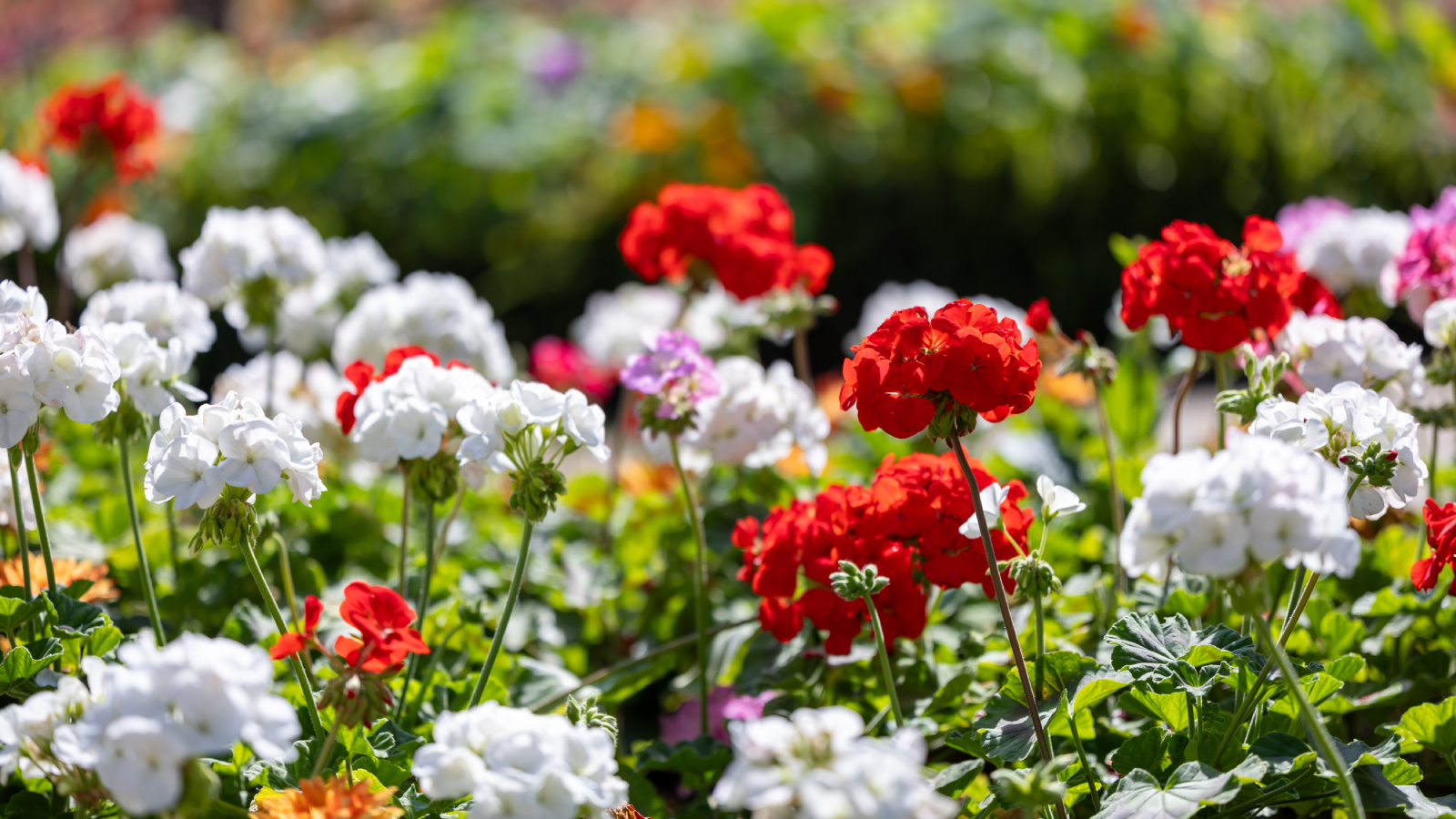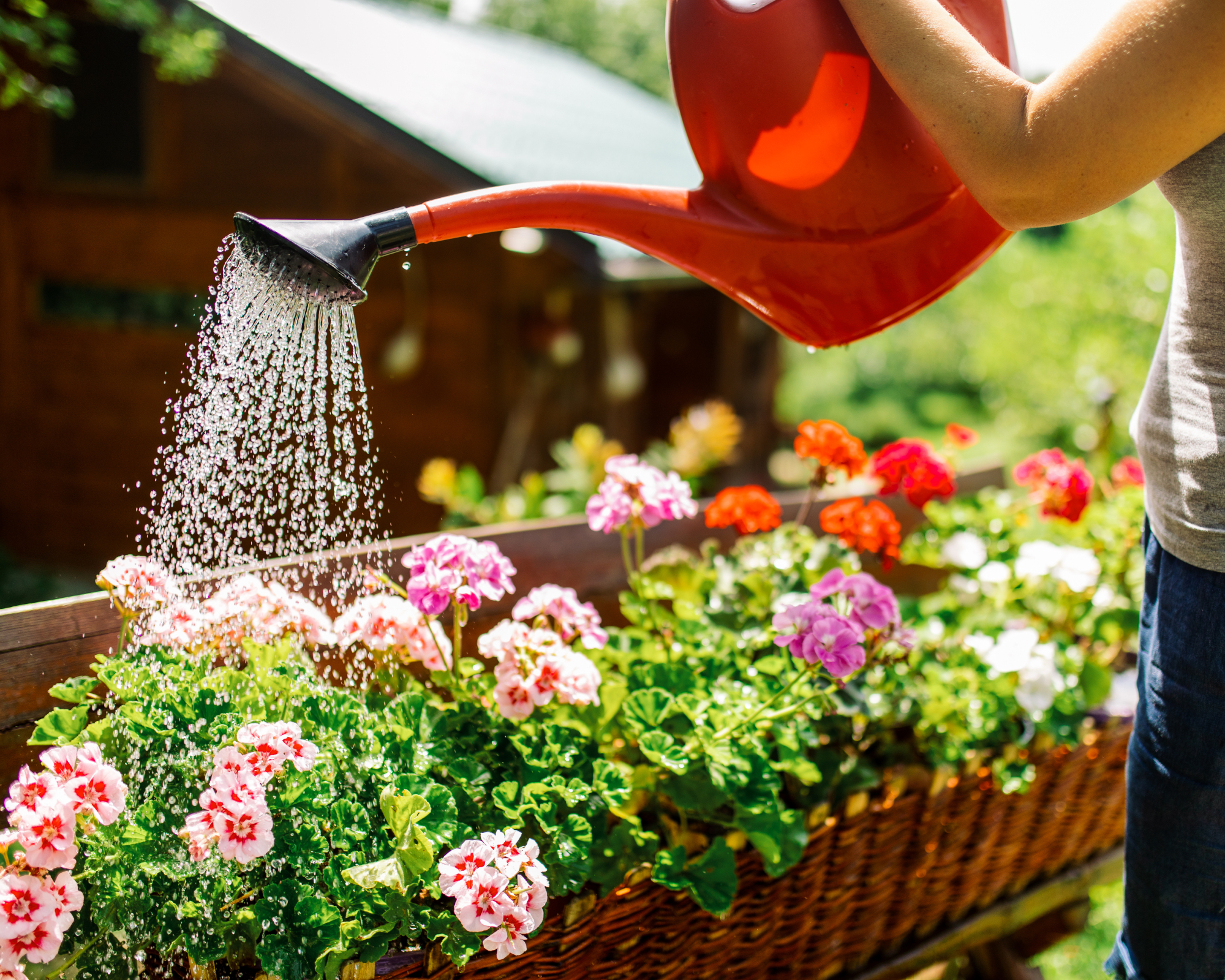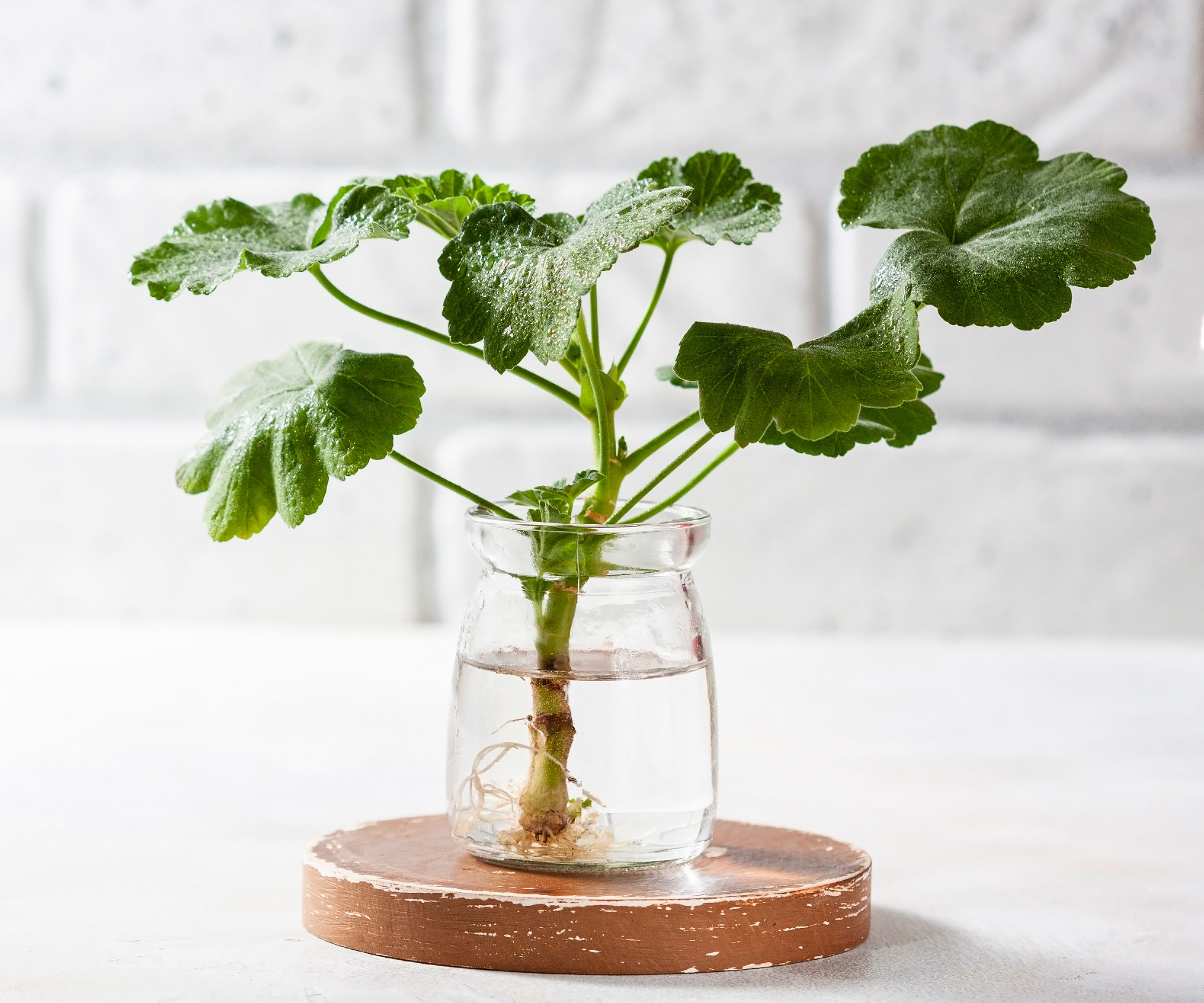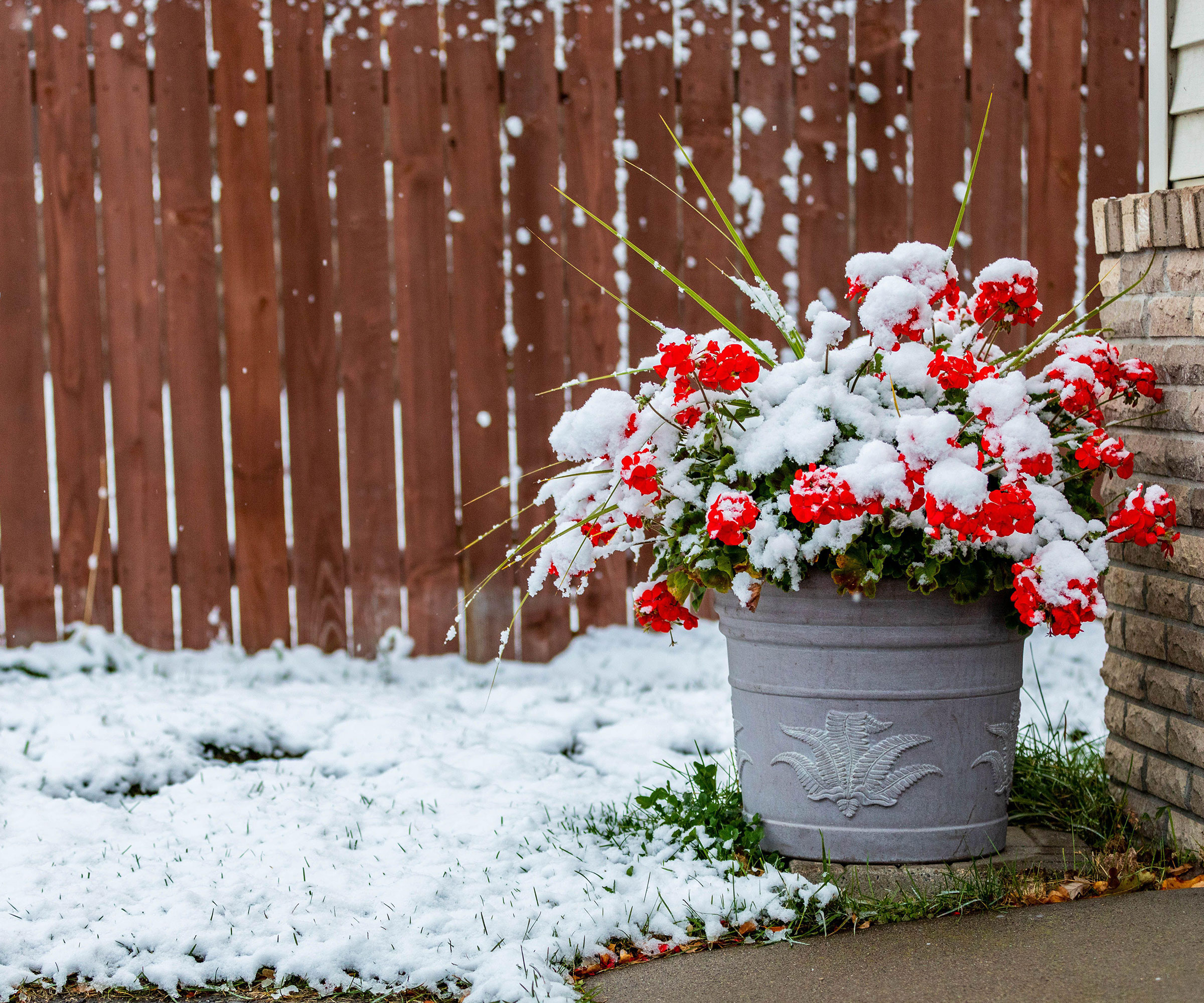How To Grow Geraniums For Bright, Beautiful Blooms All Summer Long
Geraniums have been one of the most popular garden plants for decades. Discover how to keep yours happy and blooming all summer with our complete care guide.


Quick Facts:
Botanical name: Pelargonium spp.
Height: 1-3 feet (30-91 cm)
Spread: 1-3 feet (30-91 cm)
Sun exposure: Full sun to partial shade
Soil requirements: Rich, well-drained
Hardiness zones: 10 to 11 (as perennials)
When to plant: Spring, after last frost
Geraniums are one of the most recognizable summer bedding plants, but they're not actually geraniums at all. The plant most people call "geraniums" are really pelargoniums. These classic flowers are also technically perennials, however, most home gardeners known these plants as annuals.
Geraniums (Pelargonium spp.), also known as bedding geraniums or tender geraniums, originate in the hot climates of southern Africa and Australia. Home gardeners have long prized them as container plants. Their vibrant flowers and whimsical scalloped leaves look right at home in porch pots or window boxes. Though some may consider geraniums "old-fashioned" flowers, these plants are a garden staple for good reason.
Aside from their gorgeous flowers, one of the reasons why geraniums are so beloved is how easy they are to grow. With just a bit of basic maintenance, anyone can enjoy colorful geranium blooms all summer long.
Types of Geraniums
Before we cover geranium care, let's clarify what exactly a geranium is. The plant most people in the United States call "geraniums" are actually part of the genus Pelargonium. The name comes from the Greek word pelargos, which means "stork" due to the beak-like appearance of the plant's seedpods.
Hardy geraniums (Geranium spp.) and tender geraniums (Pelargonium spp.) are related plants. They're both part of the Geraniaceae family, though they have very different care needs. That's why it's important to understand which plant you're dealing with first. In this article, we'll be discussing tender geraniums.
There are four main types of tender geranium flowers most gardeners grow, which are available to buy as a plant or seed from garden centers, or online resellers such as Amazon and Walmart:
- Most commonly grown as annuals and in beds are zonal geraniums. These are named for the different zones of color in their leaves. The flowers are usually white, pink, salmon, or red.
- Scented geraniums have interesting aromas, including varieties that smell like rose, apple, peppermint, or citronella. In fact, mosquito plants are actually a type of geranium! This type of geranium doesn't have showy flowers, though their fragrance make them a lovely addition to the garden.
- Regal, or Martha Washington geraniums are most often used as houseplants.
- Ivy geraniums, like the ones pictured below, have leaves that resemble ivy and a trailing growth habit.

Geranium Care
The easiest way to plant geraniums is from transplants, which are easy to find at nearly every garden center in spring. You’ll find cultivars propagated by seed, which are largely varieties with the single flower form. Since these plants must be protected from cold, wait until the threat of frost has passed before planting.
Sign up for the Gardening Know How newsletter today and receive a free copy of our e-book "How to Grow Delicious Tomatoes".
Space plants about 8 to 12 inches (20-30 cm) apart, and around the same depth as their original planting pots. After planting, mulch geraniums to help retain moisture and keep them hydrated through the hot summer days.
Light
Geraniums grow best in full sun but will tolerate some shade, especially at the hottest part of the day. They should get 4 to 8 hours of direct sunlight per day. Though depending on where you grow geranium plants, their needs may differ.
If you live somewhere with extremely hot summers, it's best to plant geraniums in a spot that receives some afternoon shade. If you live in a cooler climate with milder summer temperatures, geraniums can tolerate more sunlight.

When growing indoors, geraniums need lots of light for blooming but will tolerate moderate light conditions. They also need indoor temps of around 65-70 degrees F (18-21 C) during the day and 55 degrees F (13 C) at night.
Water
For outdoor plants, water geraniums when the top 1 to 2 inches (2.5 to 5 cm) of soil is dry. In hot weather, outdoor potted plants may need daily watering. Geraniums tolerate dry soil better than wet, so avoid overwatering.
If growing geraniums indoors, water deeply once the soil feels dry.
Temperature & Humidity
Geraniums originate in the hot climates of southern Africa and Australia, so they need warm temperatures to grow well. If you live in an area that experiences freezing winter temperatures, you will likely grow geraniums as annuals.
When growing geraniums from seed, you need temperatures around 70-75 degrees F (21-24 C) for germination. Mature geranium plants grow best with daytime temperatures around the same range and nighttime temperatures around 60-65 F (15-18 C).
Geraniums can survive temperatures down to 45 F (7 C), but they will stop growing around 50 F (10 C). Temperatures above 85 F (29 C) can also slow or even stop new growth.
Geraniums can tolerate low humidity and are slightly drought tolerant, though they grow best with regular watering.

Soil
Be sure to plant geraniums in well-draining soil. They do not thrive in clay, but can tolerate slightly acidic soil.
When growing geraniums outdoors, choose a well-draining potting mix. A soilless growing medium is ideal for geraniums. You can also create a homemade soilless potting mix to ensure your geraniums receive the drainage they need to thrive.
If you buy a pre-made potting mix, choose one with fertilizer included in it. Geraniums need good nutrition to put out lots of beautiful blooms, especially if you grow them as annuals. If you make your own potting mix, you can include a granular fertilizer to help feed plants all season.
Fertilizer
Fertilize your geraniums with a water-soluble houseplant fertilizer or a 5-10-5 fertilizer with additional organic matter every four to six weeks throughout their active growing season.
Problems, Pests & Diseases
The most common diseases of geraniums involve overly wet conditions. If your environment is hot, humid, and rainy then you might experience rot and mold.
To avoid these problems, space your plants far enough apart to ensure good airflow. Avoid overwatering and remove plant debris from the surrounding soil to prevent rot as well. Water geraniums gently at the soil line to keep the foliage dry and to avoid letting soil splash onto the plants.

Common infestations include aphids, whiteflies, and mites. They are more of a problem on houseplants, so watch out for early signs of pests.
Pruning
Geraniums require very little maintenance to grow well. Deadhead spent geranium blooms with a reliable set of pruners, like these Felco F6 Hand Pruners from Amazon, to keep plants flowering, and pinch off stems to encourage branching. Otherwise, you don’t really need to prune a geranium to keep it happy and thriving.
Propagation
There are two main ways to propagate geraniums, from cuttings or from seeds:
How to Propagate by Cuttings
Propagating geraniums by cuttings is the easiest and most foolproof way to grow more of your favorite summer flowers. If you live in a warm climate, take cuttings in early summer and root them in a glass of water. Transplant them into potting mix once they develop roots. You can also plant cuttings directly in soil or a soilless potting medium like perlite.
If you grow geraniums as annuals, take cuttings in late summer or early fall. Root them in water or potting mix and grow them indoors until the following spring.

How to Propagate by Seeds
You can grow geraniums from seed, but they mature slowly. You’ll need at least 8 to 10 weeks before the last frost date to get them started. Otherwise, plant rooted cuttings or transplants outside after the last frost. Geraniums are also easily propagated by taking cuttings, and some varieties must be propagated this way to ensure the right characteristics.
Overwintering
When growing them as annuals, most gardeners simply buy new geraniums each spring. A more cost-effective option is to overwinter your favorite plants. One way to do this is by taking cuttings.
You can also bring in plants before the first frost of fall and grow geraniums indoors as houseplants. Place your plant in a cool spot with bright, direct sunlight and reduce watering for the winter.
Another way to save geraniums over winter, which will provide more vigorous blooming the following year is to bring geraniums inside and allow them to go dormant.
Place potted geraniums in a cool, dark part of the house that will not get cold enough for frost. A garage or basement is ideal. Water them once a month until early spring, then move them to a sunny spot near a window. Prune off any dead leaves or stems and water regularly like a houseplant.
Once new growth emerges, fertilize plants. As soon as temperatures rise and remain above freezing in spring, plant out your geraniums.

Frequently Asked Questions
Do geraniums come back every year?
Geraniums are technically perennials, but only in USDA growing zones 10 and 11. If you live outside those zones and leave your geraniums outside all winter, they will not come back the next year. You can, however, overwinter plants and keep growing them for years as houseplants or you can replant them outdoors.
Do geraniums do better in pots or ground?
Geraniums are very good for container growing. They can tolerate drought and don't like clay soil, so if you have heavy clay soil in your garden, growing geraniums in containers is likely the best option.
Explore More Summer Blooming Beauties
- Find the perfect companion plant for your geraniums! These 9 annuals will bloom all summer long and pair perfectly for a flower-filled garden all season.
- Explore small flower bed ideas that are big on blooms and grow the garden of your dreams—no matter how much space you have!

Nikki Tilley has been gardening for nearly three decades. The former Senior Editor and Archivist of Gardening Know How, Nikki has also authored six gardening books.
- Mary Ellen EllisWriter
- Laura WaltersContent Editor